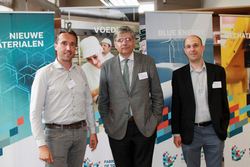Led-embedded textiles soon to reach the market
Whilst led-lighting was a technological revolution is its own right, it has so far failed to result in a totally new generation of products that breaks with previous design tradition. A way to change this would be to bring to market flexible lighting systems that would remove most existing barriers to designers’ creativity, and that’s precisely what Philips and Sioen — along with research centers under the I-TEX (Intelligent and luminous textiles) project — have been working on since 2011. ‘This is not a project just for the sake of presenting a nice gadget at a conference or exhibition’, says Dr. Bert Groenendaal, R&D project coordinator at Sioen. ‘Our objective is to come up with a product and even create new product segments: Philips concentrates on light-embedded textile for decorative or functional lighting systems, whereas we focus on light integration in the likes of trailer curtains or tents.’ Another central difference between I-TEX and previous attempts to embed lights in textiles is the size of the developed products. ‘Before I-TEX there was already some kind of state-of-the-art where people has already started to look at different ways to achieve this, but it was rather for A4-sized prototypes without a specific application in mind. We, on the other hand, wanted to show that such products can also be produced at a larger scale. We managed to reach sizes of around 10 meters square of LED-embedded substrates and can even play around with led concentrations depending on size and foreseen applications’, says Dr Groenendaal. Although the project was only granted EU-funding in 2011, Philips and Sioen had already started looking into various options over the previous year. They were then joined by three other partners: Fraunhofer, IFTH and the Technical University of Eindhoven. Soon, the new consortium identified the energy-efficient LED technology as being the most promising option for I-TEX: ‘We tried different types of LEDS, from low to high power’, explains Dr Groenendaal. ‘Then we looked at the different types of coatings that could be applied to add optical functionality, mechanical strength and waterproofing to the systems. The coatings had to be stable and some were not appropriate as they slowly degraded in time, so we put a lot of work into that.’ Another essential part of the device is the conductors. After experimenting with the likes of copper wires and screen printing, the project finally identified the most efficient solution. Overall, this research phase took two years, after which project partners brought all components together and added infrared and movement sensors to the mix. Unfortunately, the project deadline was reached before the consortium could release its first commercial product. ‘My initial hope was that we would already have a product on the market at this point, but there are still some weak points related to the production process which we have to simplify, so we are currently working on that,’ says Dr. Groenendaal. ‘But we certainly made big steps,’ he adds: ‘Three years is a relatively short period to come up with a totally new technology. Despite this time constraint we received very positive feedback from potential customers. For example products available before I-TEX didn’t include coatings, and as the biggest coated textile company in the world we were able to bring our expertise and truly go beyond the state of the art. The point for us is to make products that are reliable and can be used for years.’ Immediately after the end of the project in May 2015, Philips and Sioen agreed on a joint venture to pick up where I-TEX left off. Dr Groenendaal is hopeful that, within the next six months, the first led-embedded textile industrial prototypes can be developed for some specific markets: ‘We have now chosen specific markets and I hope we will be able to communicate about these developments somewhere next year. We also keep Horizon 2020 in the back of our mind. There are definitely some opportunities there, and if we think that the time is right to incorporate other partners we will certainly do so. In the meantime we want to keep it to a bilateral cooperation, but this could change in the coming months or years depending on our needs,’ he concludes.
Keywords
LED-embedded textiles

